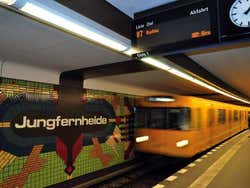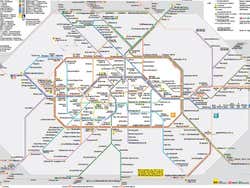
Berlin Metro (U-Bahn)
Learn about Berlin’s metro system (U-Bahn): lines, routes, rates and timetable. It is one of the most popular means of transport for tourists in the city.
The U-Bahn is Berlin’s subway system. It stands for “underground railway” in German and was built in 1902. The city’s underground played an important role during World War I, World War II and the Cold War, suffering great damages during these years, and was rebuilt numerous times. Subsequently, when the city was divided, the U-Bahn was also split and the closest metro stations to the Berlin Wall were abandoned.
Today, the Berlin U-Bahn is one of the most comfortable and easy-to-use metro networks in Europe. It gets to the city's various attractions rapidly and smoothly.
Metro Lines
The U-Bahn has nine lines that travel both underground and above ground:
- Line U1 (green): Inaugurated in 1902, it is one of the first lines to be built. It runs from east to west Berlin from the station Uhlandstraße to Warschauer Straße. U1 includes several interesting stops for tourists, like Kurfürstendamm. This stop is very close to the Kaiser Wilhelm Memorial Church or Wittenbergplatz, near the shopping mall KaDeWe.
- Line U2 (red): Another of the oldest lines is U2. This route is also interesting for tourists. It departs from Ruhleben to the west of the city and travels to the east and then terminates in the north, at Pankow. It includes stops at Alexanderplatz and Potsdamer Platz.
- Line U3 (dark green): Starts at the southeast of the city in Krumme Lanke and finishes in the city center in Nollendorfplatz. This line is not very useful for visitors unless your hotel is close to one of its stops.
- Line U4 (yellow): This line is less than 3 km long and only has 5 stations. It is the smallest in Berlin. Opened to the public in 1910, it connects Nollendorfplatz and Innsbrucker Platz.
- Line U5 (brown): The line U5 runs from Hönow to the emblematic station of Alexanderplatz. This line is very useful for getting to the popular Friedrichshain neighborhood (Frankfurter Tor station). From there, you can walk to Simon-Dache-Straße, a street full of popular restaurants.
- Line U55 (brown): an extension of the U5 line with only three stops from Hauptbahnhof to Brandenburger Tor and past the Parliament.
- Line U6 (purple): The metro line starts at Alt-Tegel, in the northeast, through Friedrichstraße, in the center, and finishes in the south at Alt-Mariendorf. One of the best-known stops is Kochstraße, the station closest to Checkpoint Charlie.
- Line U7 (light blue): The U7 is the longest underground line in Berlin, measuring 30 km with 40 stops. It runs from the northeast (Rathaus Spandau) to the southeast (Rudow). One of the most popular stops for tourists is Richard-Wagner-Platz, near Charlottenburg Palace.
- Line U8 (dark blue): It runs between Wittenau to the north of Berlin to Hermannstraße in the south.
- Line U9 (orange): Line U9 has 18 stops between Osloer Straße, to the north of the capital,l and Rathaus Steglitz. One of the most emblematic lines is Kurfürstendamm, near Kaiser Wilhelm Memorial Church.
Schedule and Frequency
On weekdays, the Berlin U-Bahn is open from 4 am to 1 am and on weekends the U-Bahn runs 24 hours a day.
During peak hours, trains run every 3 to 5 minutes. The rest of the day, a train runs every 10 minutes and at night every 15 minutes.
On Fridays, Saturdays, Sundays, and holidays, most of the routes also run almost all night.
Rates
Check out our articles on the various fares and other means of transport.
If you plan to use public transportation in Berlin during your trip, we recommend also checking out the Berlin Welcome Card. It allows unlimited use of public transportation and offers great discounts on entry to the city's main tourist attractions, as well as at shops and restaurants.


